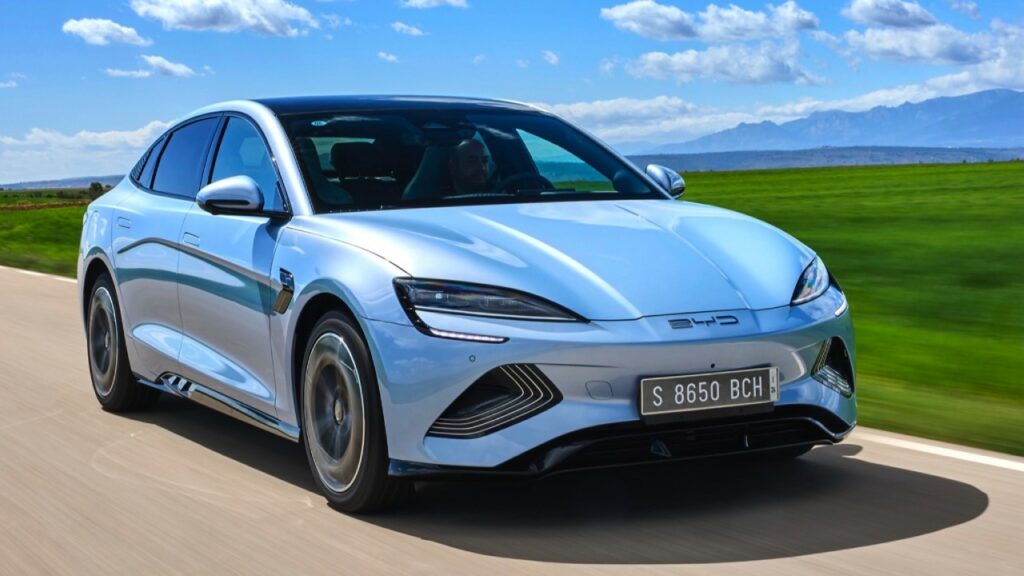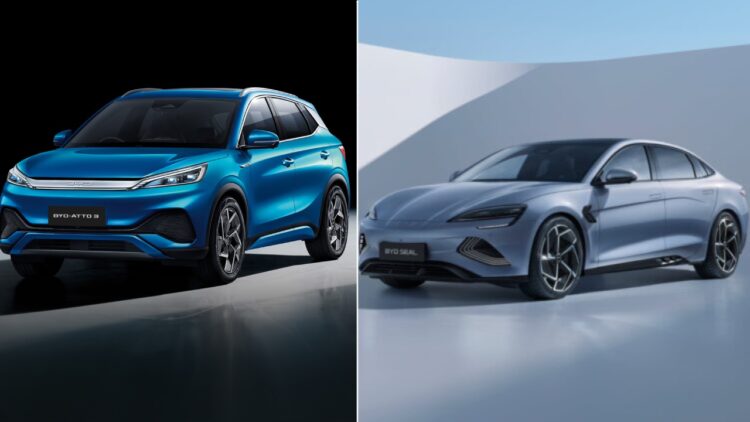BYD launched its anticipated Seal EV in our market as we bring its comparison with the Atto 3. The bookings for the same are open with an amount of Rs 1.25 lakh. The Chinese auto giant now offers three models in our market – Atto 3, e6 and Seal. The Seal is underpinned by the e-Platform 3.0. The design language is inspired by BYD’s Ocean X series. In fact, Seal gained prominence in international markets for being a worthy competitor to the Tesla Model 3. On the other hand, the Atto 3 is a relatively mass-market product from the Chinese auto manufacturer. It has been gaining traction in our market in recent times. Let us see which BYD model suits your needs the best.
You may also like: BYD Seal vs Kia EV6 – Specs, Features Comparison
BYD Seal vs Atto 3 – Specs Comparison
BYD Seal
The BYD Seal comes in multiple configurations – Dynamic, Premium and Performance. There are two Blade Battery packs on offer – a 61.44 kWh and an 82.56 kWh. These will power various configurations – single-motor RWD and dual-motor AWD. The RWD version with smaller battery pack will produce 150 kW (201 hp) / 310 Nm, while with the bigger battery, it will make 230 kW (308 hp) / 360 Nm. On the other hand, the performance-focused AWD generates 390 kW (523 hp) / 670 Nm of peak power and torque, respectively. Its range varies from 510 km to 650 km (NEDC). The most powerful iteration enables a 0-100 km/h acceleration time of just 3.8 seconds. There are 19-inch alloy wheels for the higher trims while the base model comes with 18-inch alloys. It supports 150 kW DC fast charger for the top two trims and 110 kW DC fast charger for the base model.
You may also like: BYD Seal vs Hyundai Ioniq 5 Comparison – Specs, Features, Design
BYD Atto 3
On the other hand, the Atto 3 is a crossover SUV which is also on sale in multiple international markets. It comes with a decent-sized Blade Battery pack of 60.48 kWh capacity. It powers the Permanent Magnet Synchronous Motor to produce a healthy 201 hp and 310 Nm of peak power and torque. The EV offers a range of 521 km on a single charge. The boot space is a usable 440 litre, while the ground clearance is 175 mm. Using an 80 kW DC fast charger, the vehicle can be charged to 80% in just 50 mins. This mill allows a 0-100 km/h acceleration time of just 7.3 seconds.
| Specs | BYD Seal | BYD Atto 3 |
| Battery | 61.44 kWh or 82.56 kWh | 60.48 kWh |
| Power | 201 hp – 523 hp | 201 hp |
| Torque | 310 Nm – 670 Nm | 310 Nm |
| Range | 510 km – 650 km (NEDC) | 521 km (ARAI) |
| Charging | 150 kW DC | 80 kW DC |
| Length | 4,800 mm | 4,455 mm |
| Width | 1,875 mm | 1,875 mm |
| Height | 1,460 mm | 1,615 mm |
| Wheelbase | 2,920 mm | 2,720 mm |
| Platform | e-Platform 3.0 | e-Platform 3.0 |
You may also like: India-Bound Kia EV9 a Top Contender for 2024 World Car Awards
BYD Seal vs Atto 3 – Price Comparison
The prices of the BYD Seal are quite attractive starting at Rs 41 lakh for the Dynamic variant and going up to Rs 53 lakh for the top Performance trim. On the other hand, the BYD Atto 3 has a retail price between Rs 33.99 lakh and Rs 34.49 lakh, ex-showroom. The prices of the Seal have surely taken everyone by surprise.
| Price Comparison | BYD Seal | BYD Atto 3 |
| Base Model | Rs 41 lakh | Rs 33.99 lakh |
| Mid Model | Rs 45.55 lakh | – |
| Top Model | Rs 53 Lakh | Rs 34.49 lakh |
You may also like: 15 Upcoming Electric SUVs in India – Tata Punch EV to Kia EV9
Features Comparison
BYD Seal
Being the latest offering from the Chinese carmaker, BYD Seal offers tons of modern amenities and connectivity features. These include ADAS active safety functions, silver-plated panoramic glass roof, soundproof double glazed glass for windshield and front door, 10.25-inch LCD instrumentation, a 15.6-inch rotating digital infotainment display, 8-way powered driver seat with 4-way powered lumbar support, 6-way powered passenger seat, ventilated and heated front seats, driver seat memory function, rain-sensing frameless wipers, 12-speaker DYNAUDIO music system, Voice Assistant, NFC Key Card, PM2.5 and CN95 air filter, 2 wireless smartphone charging slots, tyre repair kit, and more. It is definitely packed to the gills by the Chinese automaker. It has a full 5-star ANCAP and Euro NCAP safety rating.
You may also like: Mahindra BE.05 Spied Testing Near Jaipur
BYD Atto 3
On the other hand, the Atto 3 is also feature-rich. The long list of conveniences includes a 12.8-inch rotating infotainment display, a 5-inch digital instrument cluster, 6-way power adjustment driver and 4-way power adjustment front passenger seat, 8-speaker premium audio system, wireless smartphone charging, Voice assistant, heat pump, CN95 and PM 2.5 air filter, ADAS (Automatic Emergency Braking, Adaptive Cruise Control, Front and Rear Collision Warning, Blind Spot Detection, Land Keep Assist and Departure Warning, Rear Cross Traffic Alert, Rear Cross Traffic Brake), 360-degree monitor, panoramic sunroof, electric unlock tailgate, 4-door window one-touch up-down with anti-pinch, tyre repair kit, and more. It also has a 5-star safety rating at Euro NCAP.
You may also like: Upcoming Electric SUVs in India in 2024 – Tata CURVV to Maruti eVX

You may also like: Tesla Cybertruck Owners Complain About Rust on Pickup Truck
Author’s Note
Now both these products from BYD represent definite segments. Therefore, if you wish to associate with the Chinese carmaker and are on a strict budget, opting for the Atto 3 makes sense. It is a relatively compact EV with a crossover SUV silhouette. It offers tons of modern equipment, safety and performance. However, if you wish to experience the best BYD has to offer and are willing to be liberal with your budget, Seal has to be on your radar. The launch prices are surely mighty attractive. Apart from being the newest product from BYD, it offers significantly more engaging performance and the latest gadgets and gizmos to pamper the occupants. In any case, you can’t go wrong with either of these.


